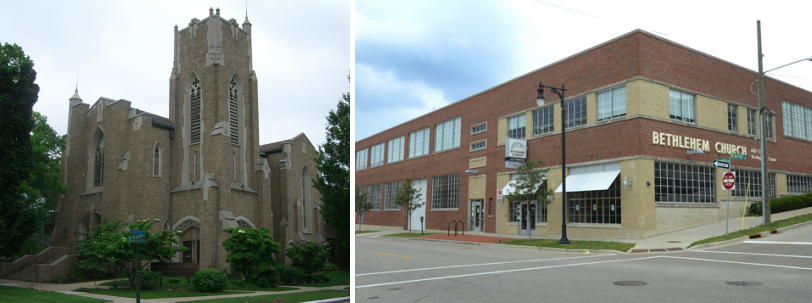Bethlehem Lutheran Church – the congregation – in Grand Rapids, Michigan, left its grand structure – the building – in 2007 and renovated and moved into a former post office maintenance garage next to a homeless shelter. The move came at a point when the congregation had been in existence for more than 130 years, founded by Swedish immigrants in 1873, and in its home since 1933 (the old church now houses apartments).
From a story at Duke University’s FaithandLeadership.com:
One of the older churches in famously devout Grand Rapids, Bethlehem followed the arc of many Protestant congregations here. Members initially met in homes, helped build the first sanctuary and weathered internal struggles.
They dedicated their imposing neo-Gothic building in 1933, high above the city amid the grand mansions of furniture barons. Forty years later, Bethlehem had swelled to 1,300 members, making it the second-largest Lutheran congregation in the city. The church supported efforts that put Heritage Hill on the national historic register in 1971.
But by the early 2000s, membership had fallen to roughly 350 worshippers, about 135 of whom regularly attended. They were hard-pressed to pay the heat, light and maintenance bills of their aging building.
The decision to sell and move was a difficult one. Council members quit, friendships dissolved and a third of the congregation left, but in the eight years since, Bethlehem Lutheran has built a younger, more vibrant congregation and a ministry that returns it to its roots.
Those who wanted to stay were honoring long-held Protestant teachings that building and maintaining churches is “kind of an offering to God,” said Bishop Craig Satterlee, the head of the ELCA’s North/West Lower Michigan Synod. But the decision to move was a courageous and faithful response to new realities, he said.
“We are at a time in the mission of the church where we really need to ask — and it’s true for so many of our congregations — whether maintaining a building is our mission,” Satterlee said. “And it can’t be.”
The church and its new building now focuses on ministries both old and new, hosting benefit concerts and working in the surrounding, impoverished neighborhood, including through the work of its ministry, The Heartside Neighborhood Collaboration Project, and the work of individual parishioners:
Since the move, more members are playing an active role in church life, Schrimpf said. Most are involved in some activity or ministry, whether singing in the choir or volunteering at a food bank. The church hosts meetings of Heartside agencies and often greets neighbors in worship.
“We’re still a mostly middle-class congregation, but it is impossible to hide from the realities or inequities of the world in our location,” Schrimpf said.
Among the questions posed by FaithandLeadership.org:
How does your church answer Bethlehem Lutheran’s questions: “ Who are we going to be? Who are we serving? What’s our mission?”
Where do vision and reality collide at your church or organization? What does it need to do to bring them closer together?
How well connected is your church to the realities of its community and context?

